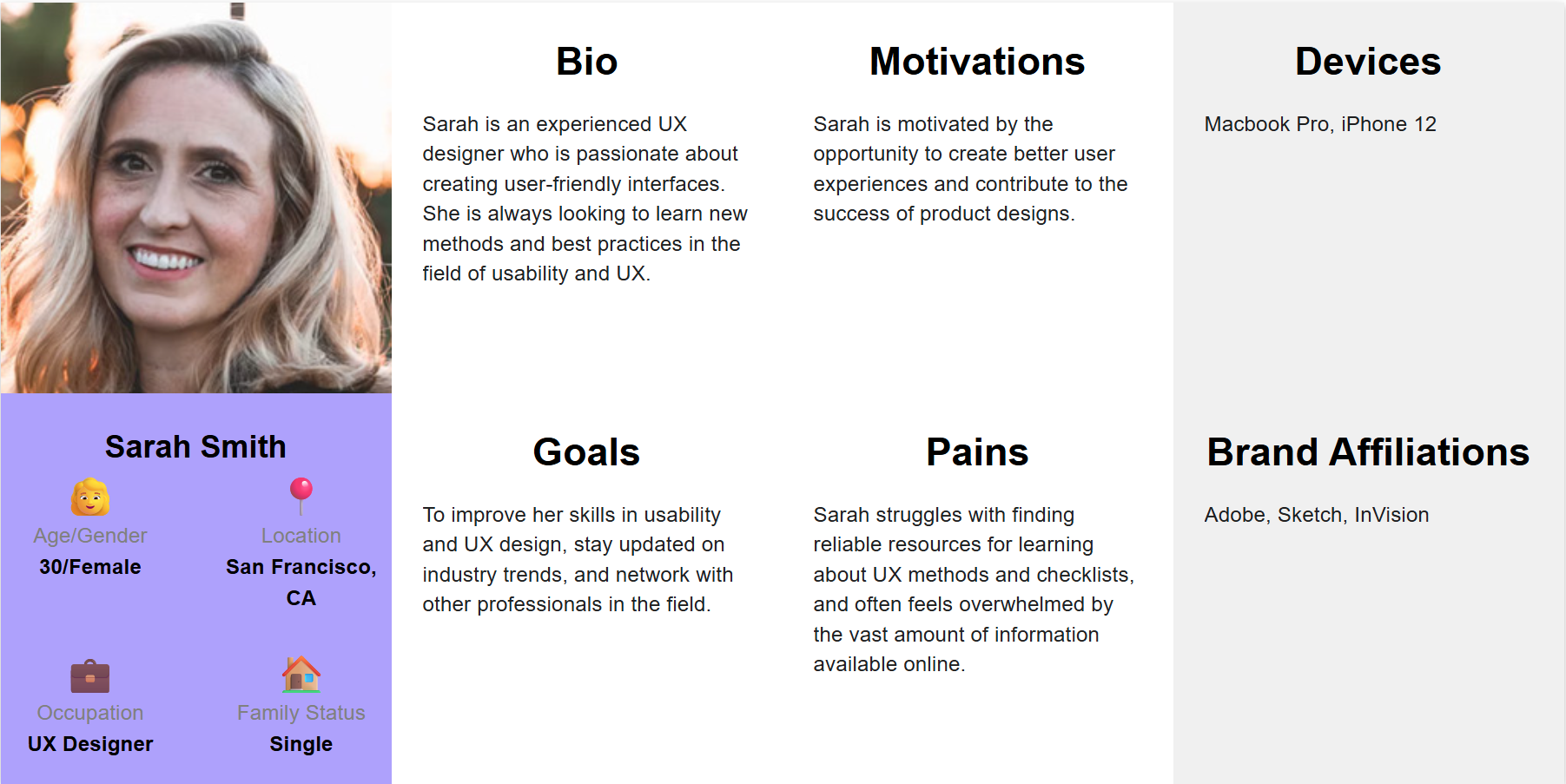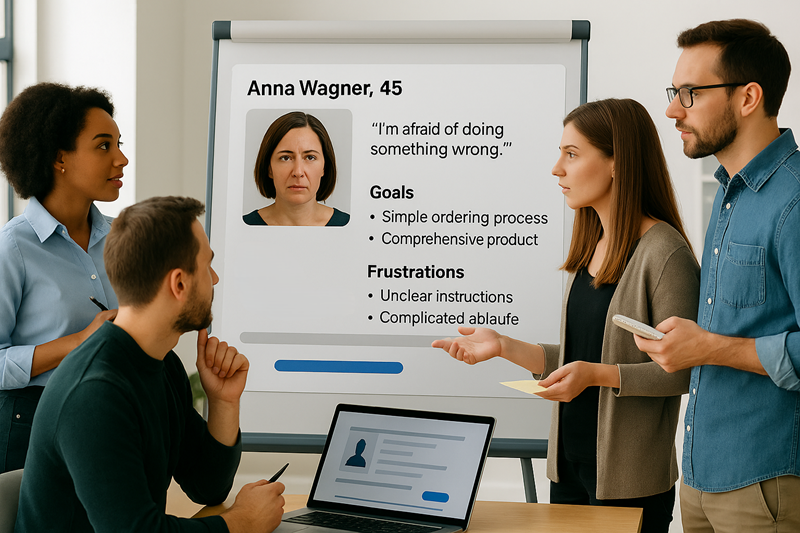Create Personas & Scenarios
Personas and Scenarios are proven instruments of user-centered design that help to make complex user groups tangible and to systematically think through specific usage contexts. Unlike purely abstract target group descriptions, personas and scenarios are based on qualitative and quantitative data - for example from interviews, observations or analytics - and offer an everyday, empathetic understanding of user reality.
Personas - Data-Based Representatives of Real Users
A persona is not an invented character to decorate presentations, but an evidence-based model type that condenses the typical needs, expectations and behavioral patterns of a user group.
Imagine this: You are developing an app for managing medication schedules. Your target group comprises older people with chronic illnesses. Instead of working with the abstract term “senior citizens”, you create a persona such as “Karl, 72, former craftsman, uses his daughter’s tablet, is afraid of technical errors and prefers to write everything down”. This concrete figure helps you to think about functional and emotional requirements throughout the design process.
Typical components of a persona are
- Name, age, profession, social role
- Goals and motives for use
- Previous technical experience and skills
- Typical usage behavior
- Frustrations (“I’m afraid of doing something wrong”) and quotes
- Context images or symbol photos for visualization
Important
A persona does not have to exist in reality - but it must be realistic. Its credibility arises from the combination of empirical findings.
Scenarios - usage stories with knowledge potential
While personas describe the person acting, Scenarios show what this person experiences with the product in a specific situation. They help to understand tasks, usage contexts and emotional hurdles realistically - often in narrative form, for example as a short everyday scene.
Example
Maria, 34, is a working mother and uses the daycare app on the streetcar in the morning to choose lunch for her daughter. As the login is reset regularly, she has to enter a new password every time - which is almost impossible to manage with one hand on her smartphone.
This scenario makes it clear what restrictions real contexts entail - such as limited usability, time pressure or distraction - and thus creates an evidence-based foundation for design priorities.

Advantages in the UX process
The main benefit of personas and scenarios is to concretize abstract requirements and to commit the design team to a common user perspective. They help:
- Self-centeredness to avoid (“I would do it this way…”)
- Set priorities in the scope of functions (“What does Lisa really need?”)
- Promoting empathy, especially in interdisciplinary teams
- Storyboards, test tasks and journeys to be coordinated
In agile teams, personas are often combined with User Stories or Jobs-to-be-Done - for example: “As Anna, I wouldn’t dare to press the buy now button because I don’t know whether the order process will be triggered.”

How are Good Personas and Scenarios Created?
Quality stands and falls with the database. A structured process includes:
- Data collection: Interviews, observations, support requests, analytics
- pattern recognition: segmentation, cluster analysis, typological derivation
- Persona creation: Condensing the profiles with narrative elements
- formulate Scenarios: Everyday usage stories with goal, context and challenge
- Comparison with stakeholders: Validation by team, product managers, customer support
Practical Example
A FinTech company analyzed chat histories and hotline inquiries to understand why users were canceling their accounts. The result: two new personas with scenarios for opening an account under stress, which later led to simplified onboarding - including prominent live chat help.
Best Practice
- Personas should be lively, but not theatrical: no caricatures, no clichés.
- Scenarios can be excellently enriched with real quotes from interviews.
- It is worth updating regularly in projects that have been running for a long time.
- Supplementary methods such as Empathy Maps or Behavioral Archetypes offer additional depth.
Conclusion
Personas and scenarios are not a “nice to have”, but the cornerstones of user-centered product development. They make user expectations tangible, create empathy and help to justify design decisions based on evidence. Those who use them not just once but continuously and base them on empirical data create the foundation for a truly relevant user experience.
Frequently asked questions (FAQ)
What are personas in UX design?
Why are personas important?
What are scenarios?
What are the components of a persona?
How do you create personas and scenarios?
What advantages do these methods offer?
Personas and scenarios in UX design
These contributions show how personas and scenario-based approaches are used in various fields of application - from education to public health - to support user-centered design processes and generate ideas.
Scenario-Based Persona for Specific Learning Difficulties
Uses combined personas scenarios to design learning aids for children with dyslexia - including co-design and visual representation.
AlSabban, M., Alorij, S., Al-Shamrani, G., & Alharbi, O. (2020). Humanistic co-design for specific learning difficulties using scenario-based personas. In HCI International. https://doi.org/10.1007/978-3-030-60149-2_3
Scenarios, Personas and User Stories in Public Health
Combines ethnographic interviews with UX design in the healthcare sector. Emphasizes realistic scenarios.
Turner, A. M., Reeder, B., & Ramey, J. (2013). Scenarios, personas and user stories. Journal of Biomedical Informatics, 46(4), 575-584. https://doi.org/10.1016/j.jbi.2013.04.006
Personas and Scenarios: Design Tool or Communication Device?
Critical reflection from an EU research project - shows benefits and limitations as a means of communication for stakeholders.
Gudjonsdottir, R., & Lindquist, S. (2008). Personas and scenarios: Design tool or a communication device? Proceedings of the 8th International Conference on Designing Cooperative Systems, COOP 2008, 165-176.
Enhancing Personas with Their Main Scenarios
Develops visually enriched persona documents with context scenarios. Focus on usability in the company.
Valls, A., Garreta-Domingo, M., & López, M. (2011). Enhancing personas with their main scenarios. In HCI International. https://doi.org/10.1007/978-3-642-21602-2_16
Facilitating Idea Generation Using Personas
Innovative use of personas to generate ideas. Combines ethnographic data with scenario-based brainstorming.
Yu, D.-J., & Lin, W.-C. (2009). Facilitating idea generation using personas. In Human Centered Design. https://doi.org/10.1007/978-3-642-02806-9_44
Last modified: 16 November 2025
